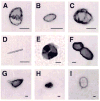Mechanistic differences in DNA nanoparticle formation in the presence of oligolysines and poly-L-lysine
- PMID: 17291071
- PMCID: PMC2548297
- DOI: 10.1021/bm0605863
Mechanistic differences in DNA nanoparticle formation in the presence of oligolysines and poly-L-lysine
Abstract
We studied the effectiveness of trilysine (Lys3), tetralysine (Lys4), pentalysine (Lys5), and poly-l-lysine (PLL) (MW 50000) on lambda-DNA nanoparticle formation and characterized the size, shape, and stability of nanoparticles. Light scattering experiments showed EC50 (lysine concentration at 50% DNA compaction) values of approximately 0.0036, 2, and 20 micromol/L, respectively, for PLL, Lys5, and Lys4 at 10 mM [Na+]. Plots of log EC50 versus log [Na+] showed positive slopes of 1.09 and 1.7, respectively, for Lys4 and Lys5 and a negative slope of -0.1 for PLL. Hydrodynamic radii of oligolysine condensed particles increased (48-173 nm) with increasing [Na+], whereas no significant change occurred to nanoparticles formed with PLL. There was an increase in the size of nanoparticles formed with Lys5 at >40 degrees C, whereas no such change occurred with PLL. The DNA melting temperature increased with oligolysine concentration. These results indicate distinct differences in the mechanism(s) by which oligolysines and PLL provoke DNA condensation to nanoparticles.
Figures







Similar articles
-
Poly(L-lysine)-induced aggregation of single-strand oligo-DNA-modified gold nanoparticles.Chemistry. 2009 Dec 7;15(47):13135-40. doi: 10.1002/chem.200900916. Chemistry. 2009. PMID: 19856341
-
Radioprotection of plasmid DNA by oligolysines.Int J Radiat Biol. 2004 Sep;80(9):643-51. doi: 10.1080/09553000400005510. Int J Radiat Biol. 2004. PMID: 15586884
-
Poly(L-lysine)-modified iron oxide nanoparticles for stem cell labeling.Bioconjug Chem. 2008 Mar;19(3):740-50. doi: 10.1021/bc700410z. Epub 2008 Feb 21. Bioconjug Chem. 2008. PMID: 18288791
-
Understanding the effect of polylysine architecture on DNA binding using molecular dynamics simulations.Biomacromolecules. 2011 Nov 14;12(11):3870-9. doi: 10.1021/bm201113y. Epub 2011 Sep 27. Biomacromolecules. 2011. PMID: 21961938
-
DNA condensation by poly-L-lysine at the single molecule level: role of DNA concentration and polymer length.J Control Release. 2008 Feb 11;125(3):252-62. doi: 10.1016/j.jconrel.2007.10.019. Epub 2007 Nov 1. J Control Release. 2008. PMID: 18068848
Cited by
-
DNA Condensation with a Boron-Containing Cationic Peptide for Modeling Boron Neutron Capture Therapy.Radiat Phys Chem Oxf Engl 1993. 2020 Jan;166:108521. doi: 10.1016/j.radphyschem.2019.108521. Epub 2019 Oct 10. Radiat Phys Chem Oxf Engl 1993. 2020. PMID: 32454570 Free PMC article.
-
Biodegradable Polymers for Gene Delivery.Molecules. 2019 Oct 17;24(20):3744. doi: 10.3390/molecules24203744. Molecules. 2019. PMID: 31627389 Free PMC article. Review.
-
A comparison of DNA compaction by arginine and lysine peptides: a physical basis for arginine rich protamines.Biochemistry. 2013 Apr 30;52(17):3000-9. doi: 10.1021/bi4001408. Epub 2013 Apr 18. Biochemistry. 2013. PMID: 23540557 Free PMC article.
-
Spiropyran in nanoassemblies as a photosensitizer for photoswitchable ROS generation in living cells.Chem Sci. 2018 Jun 11;9(26):5816-5821. doi: 10.1039/c8sc01148f. eCollection 2018 Jul 14. Chem Sci. 2018. PMID: 30079193 Free PMC article.
-
Amino Acid Sequence of Oligopeptide Causes Marked Difference in DNA Compaction and Transcription.Biophys J. 2019 May 21;116(10):1836-1844. doi: 10.1016/j.bpj.2019.04.010. Epub 2019 Apr 19. Biophys J. 2019. PMID: 31076102 Free PMC article.
References
-
- Vijayanathan V, Thomas T, Thomas TJ. Biochemistry. 2002;41:14085. - PubMed
-
- Bloomfield VA. Curr Opin Struct Biol. 1996;6:334. - PubMed
-
- Hud NV, Vilfan ID. Annu Rev Biophys Biomol Struct. 2005;34:295. - PubMed
-
- Gosule LC, Schellman JA. J Mol Biol. 1978;121:311. - PubMed
-
- Widom J, Baldwin RL. J Mol Biol. 1980;144:431. - PubMed
Publication types
MeSH terms
Substances
Grants and funding
LinkOut - more resources
Full Text Sources

